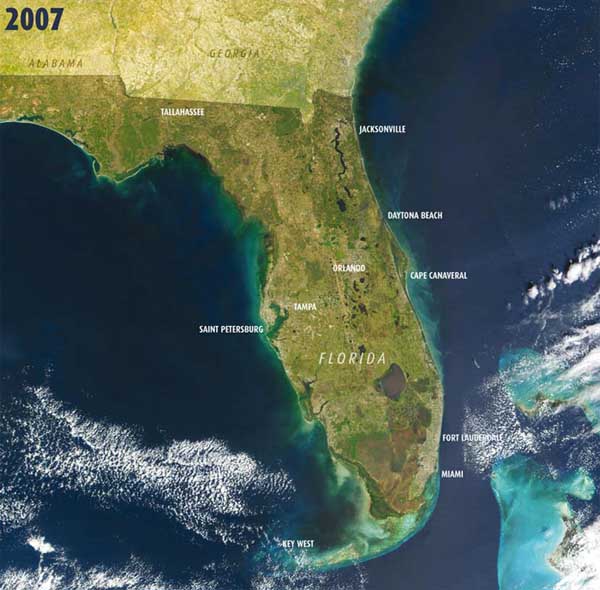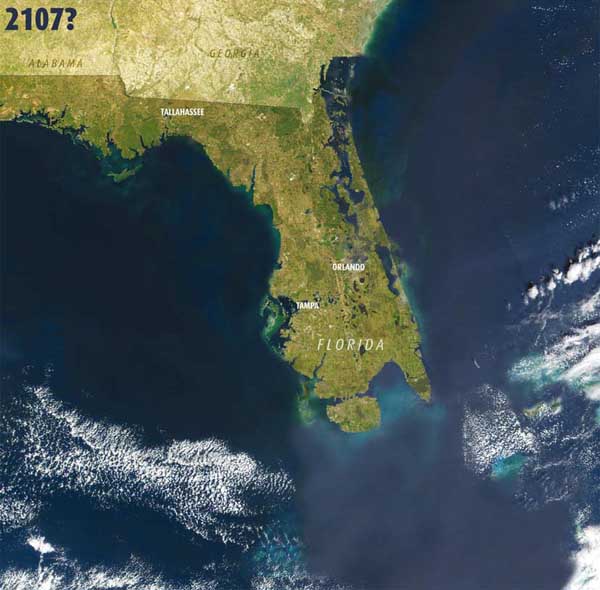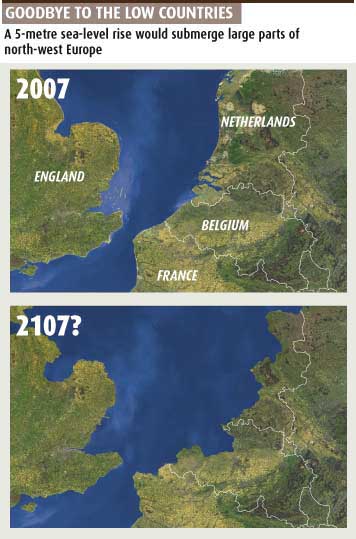 [Image: Florida in 2007; via New Scientist].
[Image: Florida in 2007; via New Scientist].In a subscriber-only article over at New Scientist, NASA climate scientist James Hansen describes what the planet might look like after a "runaway collapse" of the West Antarctic ice sheet.
The collapse, or melting, of the sheet, of course, would be caused by increased global temperatures – temperatures altered by the atmospherically unique quantity of carbon dioxide that's now floating around up there. That carbon dioxide has been released by human industrial processes.
"There is not a sufficiently widespread appreciation of the implications of putting back into the air a large fraction of the carbon stored in the ground over epochs of geologic time," Hansen writes.
 [Image: Florida in 2107; via New Scientist].
[Image: Florida in 2107; via New Scientist].In any case, the article points out that this future sea-level rise will actually increase over time, as the melting of the ice sheet itself accelerates.
- As an example, let us say that ice sheet melting adds 1 centimetre to sea level for the decade 2005 to 2015, and that this doubles each decade until the West Antarctic ice sheet is largely depleted. This would yield a rise in sea level of more than 5 metres by 2095.
From the article:
- Without mega-engineering projects to protect them, a 5-metre rise would inundate large parts of many cities – including New York, London, Sydney, Vancouver, Mumbai and Tokyo – and leave surrounding areas vulnerable to storm surges. In Florida, Louisiana, the Netherlands, Bangladesh and elsewhere, whole regions and cities may vanish. China's economic powerhouse, Shanghai, has an average elevation of just 4 metres.
However, the main problem I have with using maps and scenarios like this to get people worked up about climate change is that these warnings often seem to have the opposite effect.
In other words, these things are actually so evocative, and so imaginatively stimulating, that it's hard not to get at least a tiny thrill at the idea that you might get to see these things happen.
Nothing against Miami, but all of south Florida under several meters of water? With Cape Canaveral lost under a subtropical lagoon and St. Petersburg an archipelago?
The problem, it seems, is that climate change scientists, in describing these unearthly terrestrial reorganizations, are science fictionalizing, so to speak, our everyday existence. The implicit, if inadvertant, message here seems to be: hey, south Floridians, and all you who are bored of the world today, sick of all the parking lots and the 7-11s, tired of watching Cops, tired of applying to colleges you don't really want to go to, tired of credit card debt and bad marriages, don't worry.
This will all be underwater soon.
It could be called liberation hydrology.
Climate change becomes an adventure – the becoming-science-fiction of everyday life.
 [Image: Northwestern Europe in 2107; via New Scientist].
[Image: Northwestern Europe in 2107; via New Scientist].It seems no wonder, then, that the more apocalyptic these scenarios get, the more we find the same blasé reaction: oh, you mean Manhattan will be underwater? In 100 years?
I think the way to get people truly concerned about climate change – if fear-mongering is, in fact, the correct strategy to use here (after all, if you don't like fear-mongering in the War on Terror, then why should you apply the same tactics to climate change?) – is not by talking about unprecedented and spectacular transformations of the Earth's surface. New archipelagos! Forests in Antarctica!
Drowned cities!
Instead, it would seem, you have to point out quality of life issues: you might starve to death, for instance, as organized agriculture and food distribution chains are interrupted. Malnourished, your teeth will fall out and your hair will grow thin. You may be living in a refugee camp, with neither privacy nor close friends nor personal safety. The governments of the world may have collapsed, overwhelmed by the logistical burden of displaced populations and by the loss of the world's economic centers, like NY, London, and Shanghai; there will thus be no police; you might be physically assaulted on a regular basis. There will be rats, roaches, and rivers of human sewage – followed closely by disease, infection, infant mortality, and premature death. And you won't just be able to drive away, leaving the catastrophe behind – because the roads will be potholed, without a government to fix them, and your car will probably have been stolen, anyway. Clean water will be a luxury; you'll be drinking radiator water out of abandoned pick-up trucks, rusting on the sides of highways outside St. Louis.
In any case, my point is just that the more outlandish and imaginatively evocative your predictions get, describing some new, fantasy geography of rising sea-levels and tropical lagoons – a whole new Earth, coming your way soon – the more people will actually want to see that happen. Of course, the same thing is no doubt true for what I just wrote, above, in describing the apocalypse: after all, there are many people who will actually want to experience that – unpoliced refugee camps included.
Still, showing maps of an unrecognizable future world doesn't scare people; it taps into their explorer instinct – new lands, terra incognita.
And it gives people some truly awesome scenarios to think about – like scuba-diving through the submerged remains of Cape Canaveral, or rediscovering Amsterdam, a city lost to the silt and seaweed.
If this is what people think climate change will bring them, then a whole lot of people are probably looking forward to it.
No comments:
Post a Comment